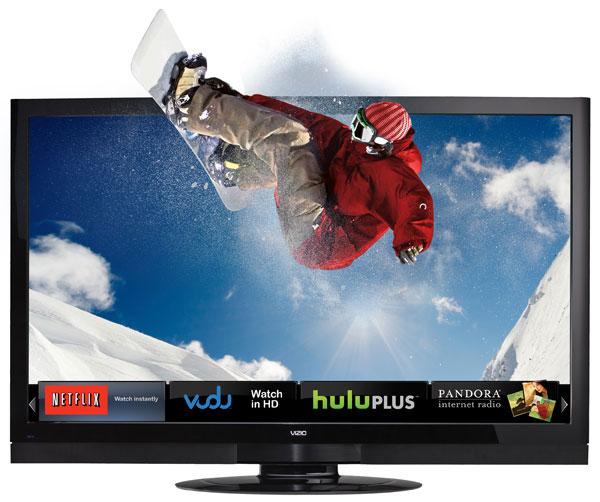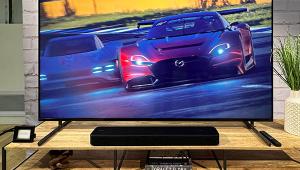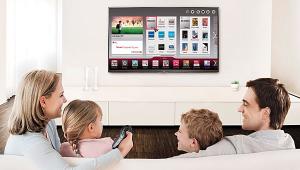Just the Facts: Flat-Panel HDTV Shopping & Tech Tips

Looking for that perfect big-screen TV? Before you hit the stores, here’s everything you need to know in a quick-read format. See our Top TV Picks.
This number refers to the number of horizontal lines of pixels counting from the top of the set to the bottom. More is better, especially at any screen size 32 inches or above. 1080p, also called Full HD, is now standard in all but the very bottom tier of HDTV or in smaller screen sizes.
Visit our How To Shop page for tips on shopping for Speakers, A/V Receivers, Blu-ray Players and more.
Plasma pros and cons at a glance:
- Self-emanating pixels illuminated by electrically charged, harmless gas sealed inside each pixel (similar concept to a fluorescent lamp).
- Outstanding black levels and contrast.
- Colors created with phosphor coating in each pixel.
- Uniform lighting on dark frames.
- Fast signal response time for natural motion rendition and good 3D performance.
- Plasma displays tend to drive less brightness than LED-driven LCD TVs. This isn’t likely to come into play except in extremely bright viewing conditions with direct sunlight washing out the screen, or in 3D viewing where extreme brightness is desirable.
- Wide viewing angle for broad seating arrangements.
- Strictly uses battery-powered active-shutter glasses for 3D (see below)
- Edge-lit: Most common. LEDs are mounted across the top/bottom or left/right edges of the screen, and an optical reflector is used to illuminate the full screen area. Hard to do well, especially on ultra-thin TVs, and many show subtle streaking or inconsistent illumination on dark scenes or frames.
- Edge-lit, local-dimming: The incoming signal information is used to dynamically dim or brighten specific groupings of LEDs to accommodate the demands of the image. Can provide improved contrast over edge-lit sets without this feature, but far less specific than full-array/local-dimming models (see below)
- Full-array: A large grid of LEDs is spread behind the screen. Provides more even lighting than edge-lit LED LCDs, but may be more costly and may not provide as good contrast as an edge-lit, local-dimming HDTV. Full-array LED backlight is particularly valuable on large panels of 60-inches and above, where it is more difficult to spread edge-lighting evenly across the screen.
- Full-array with local dimming: A grid of LEDs is controlled dynamically scene by scene to independently darken or brighten only those areas of the image that require it, producing deep blacks and bright highlights within the same frame. The best and most costly approach, and found only in the best LCD HDTVs.
- Colors are created by shining the backlight through red, green and blue filters in the LCD panel.
- Contrast/black levels can range from poor on some non-local dimming, edge-lit models to plasma-level performance on the best full-array, local-dimming models.
- LED-backlit LCDs are usually able to create a brighter picture than plasma, though this will only come into play in very high ambient light.
- Signal response times for LCD are inherently slower than plasma panels, which can lead to visible image-lag or blurring on fast motion or camera pans. Most LCD HDTVs now offer a “motion interpolation” feature that compensates by increasing the screen refresh rate to 120 hertz (Hz) or 240 Hz. This feature (which is usually turned on by default on store display models), gives film-based content an unnatural, video-like sheen that some viewers prefer to the more natural, film-like look imparted when this feature is turned off. If you watch movies and don’t like this look, audition prospective TVs with this featured deactivated in the set’s menu.
- More narrow viewing window than plasma, sometimes very narrow. If this is critical for your room setup, check store display models from your anticipated seating distance to see how far off center you can go before color shifts or contrast/brightness noticeably drops off.
- 3D glasses may be active-shutter type or passive type depending on manufacturer or model.
This number refers to the number of horizontal lines of pixels counting from the top of the set to the bottom. More is better, especially at any screen size 32 inches or above. 1080p, also called Full HD, is now standard in all but the very bottom tier of HDTV or in smaller screen sizes.
3D and resolution
- 3D now comes along for the ride in better mid- to high-priced 2D HDTVs.
- Availability of 3D cable/satellite programming and home movie titles remains limited.
- Requires 3D-compatible Blu-ray player for 3D Blu-ray playback. 3D players also play 2D Blu-ray and DVD discs.
- Passing 3D signals through an A/V receiver to your TV to allow simplified video switching of different sources requires a receiver compliant with HDMI version 1.4. If you have an older receiver with an earlier version of HDMI, a separate high-speed rated HDMI cable will have to be run from your 3D Blu-ray player directly to the TV, and you’ll ideally want a 3D Blu-ray player with dual HDMI outputs so you can acquire the highest quality sound from Blu-ray discs.
- Crosstalk, or ghosting, is found in both active-shutter and passive 3D systems (see below), though this was more common in the early days of 3D. The television, the glasses, and the programming all contribute to this occasional artifact, but certain HDTVs are better at suppressing it. Read Home Theater TV reviews to get some idea of how a prospective set fares in this area. Home Theater provides separate 2D and 3D performance ratings for the HDTVs we test.














































